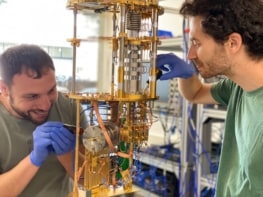
A new nanostructured flat surface that appears like a 3D object – complete with realistic light shading and shadows – has been developed by Alexander Minovich, Anatoly Zayats and colleagues at Kings College London and the Rheinische Friedrich-Wilhelms-Universität Bonn. The optical illusion relies on a computer-graphics technique called “normal mapping”, which creates 3D objects with realistic lighting effects on a 2D display.
The surface comprises a gold film 180 nm thick that is covered with a 105 nm layer of magnesium fluoride. Squat rectangular pillars of gold 30 nm tall are arranged in an array on the surface of the magnesium fluoride, which acts as a transparent spacer between the gold film and the pillars.
Shadow and contrast
Normal mapping was then used to compute the orientation of each pillar so that light reflecting from the surface appears as a cube (see figure). What is more, when the surface is illuminated or viewed from different angles, the cube appears to have the appropriate shadow and contrast.
Potential applications of the surface include optical security features on banknotes and other objects prone to counterfeiting. “The normal mapping demonstrated with our metasurface is a completely new concept, but it could have very important implications for a wide range of optical industries, both in introducing new functionality and making products smaller and lighter,” says Minovich.



